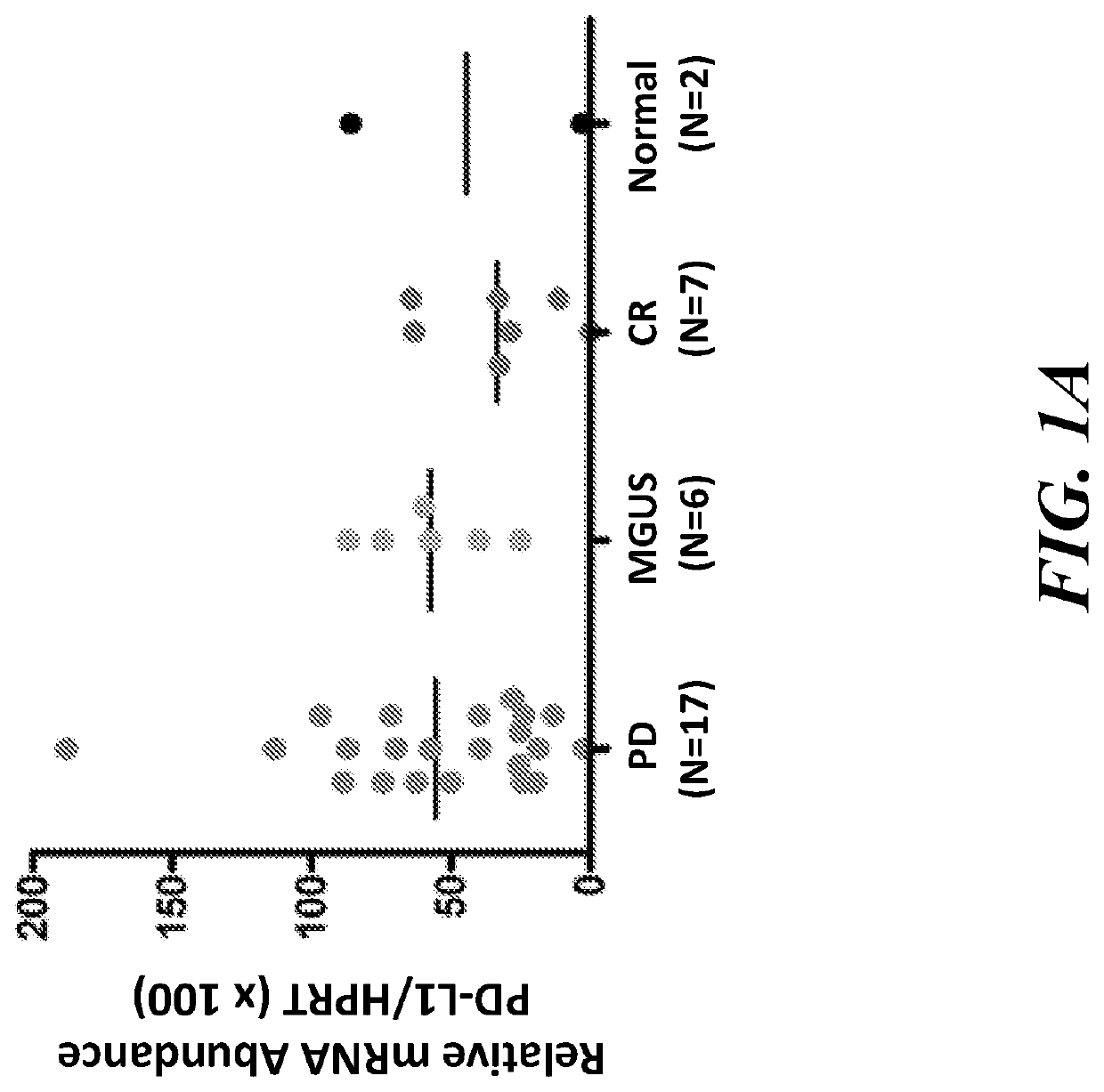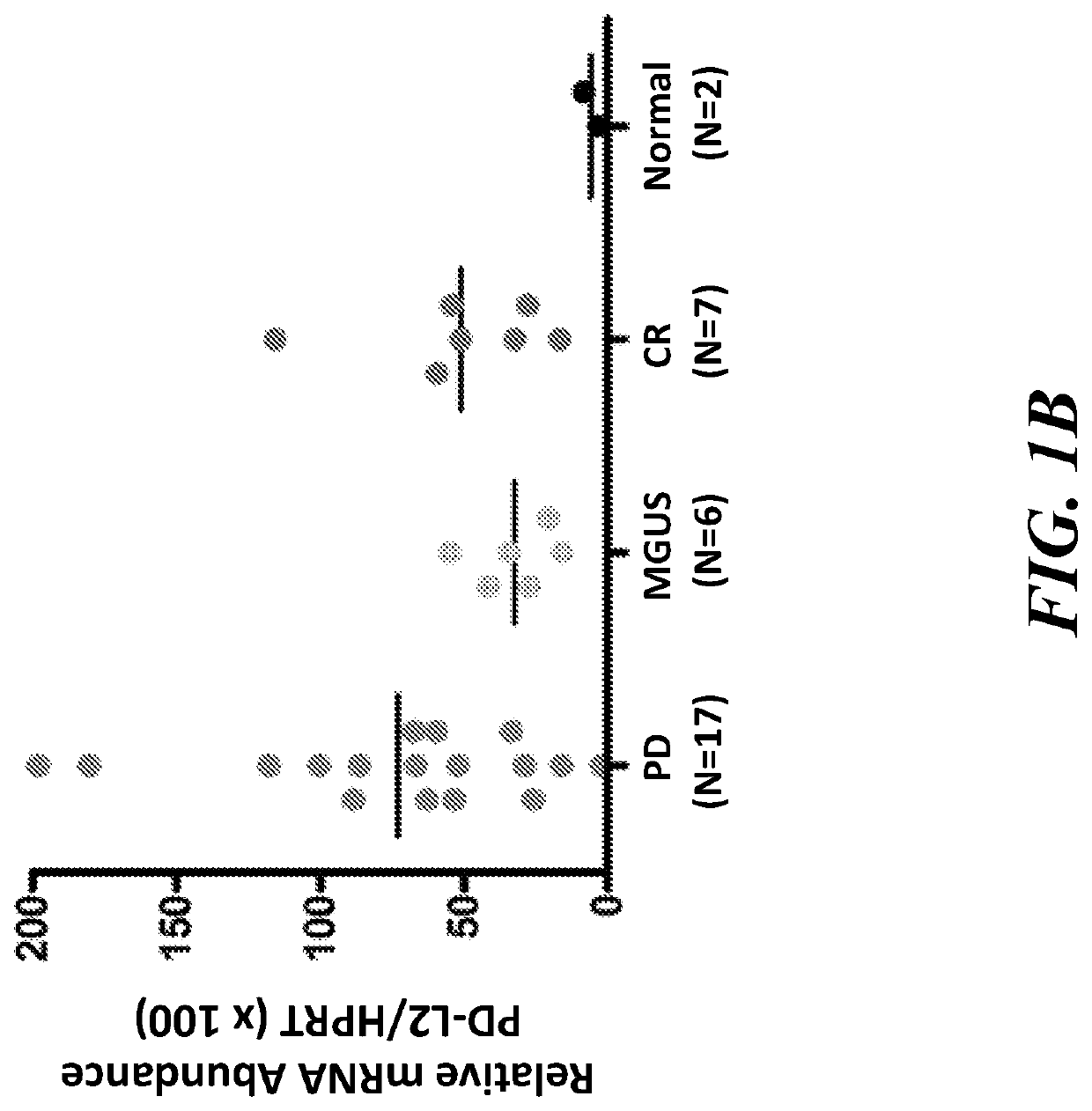Method of enhancing immune-based therapy
a technology of immune-based therapy and immunomodulatory therapy, which is applied in the field of immunomodulatory therapy to achieve the effect of increasing the efficacy of an immune-based therapy
- Summary
- Abstract
- Description
- Claims
- Application Information
AI Technical Summary
Benefits of technology
Problems solved by technology
Method used
Image
Examples
example 1
PD-L2 Gene Expression is Increased in Multiple-Myeloma Patients with Progressive Disease (PD)
[0189]Bone marrow mononuclear cells (BMMCs) from multiple myeloma (MM) patients with progressive disease (PD) or in complete remission (CR) were isolated and analyzed using qPCR. We examined PD-L1 gene expression in MM patients with PD or in CR and those with monoclonal gammopathy of undetermined significance (MGUS) or healthy subjects (Normal). The results showed that PD-L1 gene expression measured at the mRNA level using quantitative PCR (qPCR) was markedly increased in BMMCs from MM patients with PD compared with those patients in CR or with MGUS. (FIG. 1A). PD-L2 gene expression was also increased among MM patients with PD compared with those patients in CR (FIG. 1B).
example 2
e Expression is Higher in CD138+ Myeloma Tumor Cells than CD138-Bone Marrow Mononuclear Cells (BMMCs)
[0190]PD-L1 and PD-L2 gene expression was measured in CD138+ myeloma tumor cells and in CD138− mononuclear cells from the bone marrow of MM patients with PD (n=14) and in CR (n=1). The observed upregulation of PD-L1 in co-cultures with stromal cells indicated that upregulation occurs in nontumor cells within the patient-derived sample. CD138+ plasma cells were isolated by anti-CD138 antibody with magnetic beads and CD138− cells from bone marrow mononuclear cells were also collected for evaluation using a standard qPCR assay. PD-L1 (FIG. 2A) and PD-L2 (FIG. 2B) gene expression in CD138+ myeloma tumor cells was much higher than among CD138− mononuclear cells in the BMMCs. In the figure, + indicated the CD138+ cells and − indicates the CD138− cells.
example 3
PD-L2 Expression in a MM Patient was Reduced by Co-Administration of Ruxolitinib, Methylprednisolone, and Lenalidomide
[0191]Both PD-L1 and PD-L2 gene expression was significantly reduced in bone marrow mononuclear cells (BMMCs) after 4 months of treatment with a RUX combination with other anti-myeloma agents (FIG. 3A and FIG. 3B). BMMCs were collected from a MM patient (who had previously treated and failed therapy with methylprednisolone and pomalidomide) before commencing treatment with ruxolitinib, methylprednisolone, and lenalidomide. A second sample of BMMCs was collected after treatment with ruxolitinib, methylprednisolone, and lenalidomide. PD-L1 (FIG. 3A) and PD-L2 (FIG. 3B) gene expression, measured by qPCR, were markedly reduced after the patient was treated with ruxolitinib, methylprednisolone and lenalidomide.
PUM
| Property | Measurement | Unit |
|---|---|---|
| weight | aaaaa | aaaaa |
| concentration | aaaaa | aaaaa |
| concentration | aaaaa | aaaaa |
Abstract
Description
Claims
Application Information
 Login to View More
Login to View More - R&D
- Intellectual Property
- Life Sciences
- Materials
- Tech Scout
- Unparalleled Data Quality
- Higher Quality Content
- 60% Fewer Hallucinations
Browse by: Latest US Patents, China's latest patents, Technical Efficacy Thesaurus, Application Domain, Technology Topic, Popular Technical Reports.
© 2025 PatSnap. All rights reserved.Legal|Privacy policy|Modern Slavery Act Transparency Statement|Sitemap|About US| Contact US: help@patsnap.com



